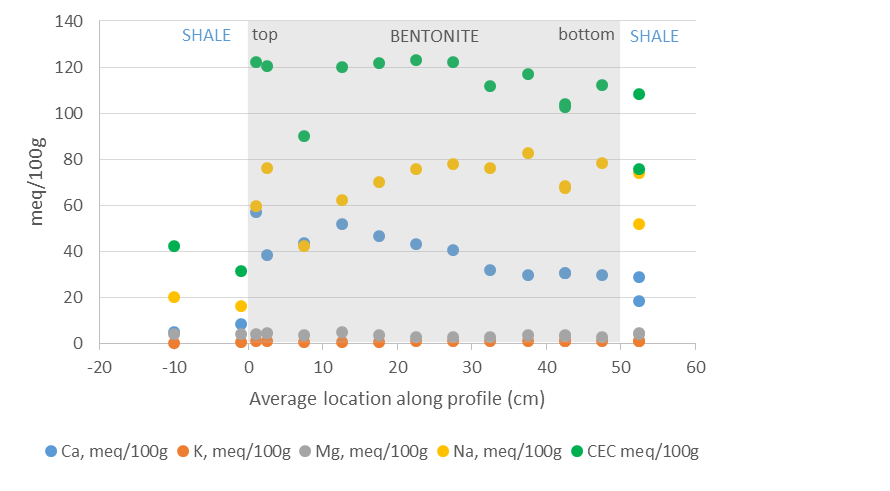397IBL (International Bentonite Longevity) project: preliminary results
Abstract
Introduction
Kunimine Industries Company (KIC)’s Tsukinuno (NW Japan) deep bentonite mine is a source of Miocene age (ca. 12-16 Ma) Na- (at depth) and Ca- (near-surface) bentonite. The site is ideal for studying processes of direct relevance to safety cases (SC) for radioactive waste repositories which utilise bentonite as part of their multi-barrier safety systems. The International Bentonite Longevity (IBL) project is focussed on studying a range of long-term, repository safety-relevant processes and these are described in Norris et al. (this meeting).
Preliminary results
XRD results show that bentonite composition is repository relevant (smectite content of 8-70 wt%, with the low values due to large calcite/anorthite/quartz clasts in these samples). Groundwater-bentonite reaction is seen in the chemical analysis with:
CEC and EC (Figure 1) – change in Ca and Na is seen, especially close to the bentonite top contact where groundwater is observed in the shale
Chemical composition (Ca-concentration) – the solid phase Ca content mimics that of the exchangeable Ca with a peak some 13 cm below the bentonite/shale contact
Both data sets show disturbance around the bentonite/shale contact, presumably indicating groundwater-bentonite interaction
Structural analysis of the bentonite by XCT (X-ray computed tomography) has provided details of internal deformation (including fracturing and faulting)
The preliminary assessment of the in situ microbiological populations in the bentonite are presented in Kremer et al. (this meeting) and so are not discussed further here.
Summary and conclusions
Preliminary results indicate that, although long-term, groundwater-bentonite interaction induces cation exchange, no major changes appear to have occurred in the bentonite physical properties. Whilst the drillcore samples are awaiting full examination, XCT has already been carried out, providing a detailed description of the fine internal characteristics of the bentonite beds (see Reijonen & Alexander, 2021, for details). Preliminary microbial population results are presented in Kremer et al. (this meeting).
Figure 1. CEC and EC values for Ca, K, Mg and Na across the sampled profile in bentonite bed #17 (Reijonen & Alexander, 2021).
Future outlook
Ongoing analyses includes a full physico-chemical characterisation of the Bed #17 samples to provide information on density, saturation state etc. In addition, NDS (natural decay series) analyses of the clay, shale and groundwaters will provide information on the period and duration of groundwater-bentonite interaction allowing the results to be placed in context for a repository SC.
The IBL project is being developed further as an international collaboration between multiple WMOs, please see www.iblproject.com for further details.
Acknowledgements
This work is supported as part of the ongoing NWMO/NUMO/GTK co-funded IBL Project. Phase A of the IBL project was funded by NWS Ltd (UK) through the Jacobs managed Borehole Sealing project. Access to the mine and logistical support kindly provided by KIC, Japan.
References
Reijonen, H.M. & Alexander, W.R. (2021). International Bentonite Longevity (IBL) project report - Phase A. Jacobs Report to NWS. NWS Ltd., Harwell, UK (in press).
